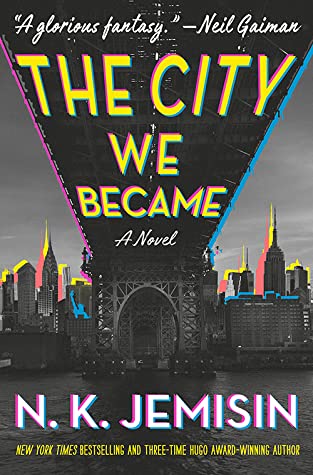- The Good: A makeshift family comes together as New York avatars
- The Bad: Low plot momentum; logical explanations of fantasy unnecessary
- The Literary: Lovecraftian monsters as personifications of prejudice
What if a city had a soul? What if, at some size, cities became self-aware, embodied in a human avatar? In this novel based on Jemisin’s 2016 short story, “The City Born Great”, five very different people awaken to the knowledge that they are avatars of New York City’s five boroughs, each with their own unique powers.
- Manhattan, better known as Manny, forgets his former life when he becomes an avatar. When normal New Yorkers are around him, they can see the invisible enemy.
- A successful lawyer and councilwoman, Brooklyn’s power is rooted in her former career as a rapper.
- Bronca works at the Bronx art center and as the elder avatar serves as the repository of knowledge.
- Padmini, a stressed out graduate student living in Queens, refuses to be called by her borough. She uses her math skills to understand the new rules of reality.
- Still living at home with her parents, Aislyn is caught between wanting to leave behind Staten Island for good or staying with her abusive, racist cop father, whom she loves.
I love the premise of this story and the way the characters come together. The relationships between the protagonists feel real, like a big family that can’t stop fighting. Their dialogue and encounters are ordinary, the humor relatable, complete with curse words, loud music, honking cars, and lots of people yelling out their windows to shut up. Even the villain lends a street-level heroism of the ordinary underdog citizen against cops and corporations. It’s clear that this is Jemisin’s love letter to her city. As I’ve never been to New York, I do feel a little left out, like I don’t quite get the nuance of a joke at which everyone else is laughing.
Amidst the strong sense of time and place is a fun monster story. The enemy is a Lovecraftian alien life-form that presents itself as giant tentacles that crush bridges, contagious fungal fronds that grow out of people’s faces, and crawly spider-like creatures, as well as the Woman in White when it wants to speak. Much of the book consists of our heroes fighting apparitions as they pop up throughout the city while trying to assemble the team. With the help of the avatars of Sao Paulo and Hong Kong, they nearly succeed.
The best fantasy is about something, and this urban horror fantasy is weighty because of its bold inclusivity. The protagonists are mixed, black, Indian, Native American, and Irish, with some good LBGTQ representation as well. The Lovecraftian enemy is a literal embodiment of the xenophobia and racism that exists in much of Lovecraft’s work. Normal everyday prejudices are incorporated into the fantastical over-the-top enemy. It’s unapologetically unsubtle, and I think fantasy readers will appreciate the social candor paired with the in your face interdimensional monster story.
While I hesitate to compare this to a completely different series, The City We Became doesn’t hold the same gravitas as Jemisin’s The Fifth Season, which speaks with nuance to modern themes of oppression and race among a rich tapestry of world-building while keeping the stakes high. The lengthy dialogue between characters and social commentary speeches in this novel are on point, but they also slow the momentum and urgency. The parallels between racism and the enemy are clever, but they don’t accelerate the plot.
Recommended for lovers of the Big Apple and monster stories!
